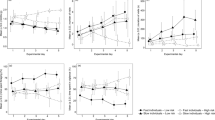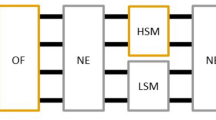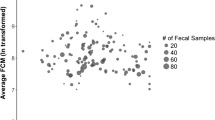Abstract
Between-individual differences in coping with stress encompass neurophysiological, cognitive and behavioural reactions. The coping style model proposes two alternative response patterns to challenges that integrate these types of reactions. The “proactive strategy” combines a general fight-or-flight response and inflexibility in learning with a relatively low HPA (hypothalamic–pituitary–adrenal) response. The “reactive strategy” includes risk aversion, flexibility in learning and an enhanced HPA response. Although numerous studies have investigated the possible covariance of cognitive, behavioural and physiological responses, findings are still mixed. In the present study, we tested the predictions of the coping style model in an unselected population of bank voles (Myodes glareolus) (N = 70). We measured the voles’ boldness, activity, speed and flexibility in learning and faecal corticosterone metabolite levels under three conditions (holding in indoor cages, in outdoor enclosures and during open field test). Individuals were moderately consistent in their HPA response across situations. Proactive voles had significantly lower corticosterone levels than reactive conspecifics in indoor and outdoor conditions. However, we could not find any co-variation between cognitive and behavioural traits and corticosterone levels in the open field test. Our results partially support the original coping style model but suggest a more complex relationship between cognitive, behavioural and endocrine responses than was initially proposed.
Significance statement
Understanding the proximate mechanisms regulating the individual variation in responses to environmental challenges and changes is fundamental in ecological and evolutionary research. Theory predicts correlations between behavioural, cognitive and physiological traits to form alternative strategies named coping styles but recent studies report contrasting and mixed findings. We examined the relationship between a measure of endocrine state (concentrations of faecal glucocorticoid metabolites), two behavioural traits (boldness and activity) and two cognitive traits (speed and flexibility of learning) in 70 unselected bank voles (Myodes glareolus) under three different conditions. The findings partially support the original coping style model’s hypothesis and predictions. We found individual consistency of all traits. However, correlations between behavioural and cognitive aspects and endocrine state were found only in two of the three tested conditions, highlighting the need for further investigations and testing of theory.



Similar content being viewed by others
Data availability
Data are available as supplementary material
References
Archer J (1973) Tests for emotionality in rats and mice: a review. Anim Behav 21:205–235
Bates D, Mächler M, Bolker B, Walker S (2015) Fitting linear mixed-effects models using lme4. J Stat Softw 67:1–48
Bats S, Thoumas JL, Lordi B, Tonon MC, Lalonde R, Caston J (2001) The effects of a mild stressor on spontaneous alternation in mice. Behav Brain Res 118:11–15
Bebus SE, Small TW, Jones BC, Elderbrock EK, Schoech SJ (2016) Associative learning is inversely related to reversal learning and varies with nestling corticosterone exposure. Anim Behav 111:251–260
Benus RF, den Daas S, Koolhaas JM, van Oortmerssen GA (1990) Routine formation and flexibility in social and non-social behaviour of aggressive and non-aggressive male mice. Behaviour 112:176–193
Blanchard RJ, McKittrick CR, Blanchard DC (2001) Animal models of social stress: effects on behavior and brain neurochemical systems. Physiol Behav 73:261–271
Blondel DV, Wallace GN, Calderone S, Gorinshteyn M, Mary CM, Phelps SM (2016) Effects of population density on corticosterone levels of prairie voles in the field. Gen Comp Endocr 225:13–22
Bonnot NC, Bergvall UA, Jarnemo A, Kjellander P (2018) Who’s afraid of the big bad wolf? Variation in the stress response among personalities and populations in a large wild herbivore. Oecologia 188:85–95
Boratyński Z, Koteja P (2009) The association between body mass, metabolic rates and survival of bank voles. Funct Ecol 23:330–339
Bosson CO, Palme R, Boonstra R (2009) Assessment of the stress response in Columbian ground squirrels: laboratory and field validation of an enzyme immunoassay for fecal cortisol metabolites. Physiol Biochem Zool 82:291–301
Boulton K, Couto E, Grimmer AJ, Earley RL, Canario AV, Wilson AJ, Walling CA (2015) How integrated are behavioral and endocrine stress response traits? A repeated measures approach to testing the stress-coping style model. Ecol Evol 5:618–633
Brockmann HJ (2008) Integrating mechanisms and function: prospects for future research. In: Oliveira RF, Taborsky M, Brockmann HJ (eds) Alternative reproductive tactics: an integrative approach. Cambridge University Press, Cambridge, pp 471–489
Buchanan KL, Grindstaff JL, Pravosudov VV (2013) Condition dependence, developmental plasticity, and cognition: implications for ecology and evolution. Trends Ecol Evol 28:290–296
Bujalska G (1975) Reproduction and mortality of bank voles and the changes in the size of an island population. Acta Theriol 20:41–56
Carere C, van Oers K (2004) Shy and bold great tits (Parus major): body temperature and breath rate in response to handling stress. Physiol Behav 82:905–912
Carere C, Groothuis TGG, Möstl E, Daan S, Koolhaas JM (2003) Fecal corticosteroids in a territorial bird selected for different personalities: daily rhythm and the response to social stress. Horm Behav 43:540–548
Carere C, Caramaschi D, Fawcett TW (2010) Covariation between personalities and individual differences in coping with stress: converging evidence and hypotheses. Curr Zool 56:728–740
Carola V, D’Olimpio F, Brunamonti E, Mangia F, Renzi P (2002) Evaluation of the elevated plus-maze and open-field tests for the assessment of anxiety-related behaviour in inbred mice. Behav Brain Res 134:49–57
Cockrem JF (2007) Stress, corticosterone responses and avian personalities. J Ornithol 148:169–178
Cooperman MD, Reed JM, Romero LM (2004) The effects of terrestrial and breeding densities on corticosterone and testosterone levels in spotted salamanders, Ambystoma maculatum. Can J Zool 82:1795–1803
Crane AL, Ferrari MC (2017) Patterns of predator neophobia: a meta-analytic review. Proc R Soc B 284:20170583
Cyr NE, Romero LM (2007) Chronic stress in free-living European starlings reduces corticosterone concentrations and reproductive success. Gen Comp Endocr 151:82–89
Davis AK, Maerz JC (2011) Assessing stress levels of captive-reared amphibians with hematological data: implications for conservation initiatives. J Herpetol 45:40–45
de Lourdes Ruiz-Gomez M, Huntingford FA, Øverli Ø, Thörnqvist P-O, Höglund E (2011) Response to environmental change in rainbow trout selected for divergent stress coping styles. Physiol Behav 102:317–322
Dickens MJ, Delehanty DJ, Romero LM (2010) Stress: an inevitable component of animal translocation. Biol Conserv 143:1329–1341
Dingemanse NJ, Dochtermann NA (2013) Quantifying individual variation in behaviour: mixed-effect modelling approaches. J Anim Ecol 82:39–54
Dingemanse NJ, Wolf M (2010) Recent models for adaptive personality differences: a review. Phil Trans R Soc B 365:3947–3958
Dingemanse NJ, Both C, Drent PJ, Tinbergen JM (2004) Fitness consequences of avian personalities in a fluctuating environment. Proc R Soc Lond B 271:847–852
Dingemanse NJ, Kazem AJ, Réale D, Wright J (2010) Behavioural reaction norms: animal personality meets individual plasticity. Trends Ecol Evol 25:81–89
Eccard JA, Jokinen I, Ylönen H (2011) Loss of density-dependence and incomplete control by dominant breeders in a territorial species with density outbreaks. BMC Ecol 11:16
Ellis T, James J, Stewart C, Scott A (2004) A non-invasive stress assay based upon measurement of free cortisol released into the water by rainbow trout. J Fish Biol 65:1233–1252
Fauteux D, Gauthier G, Berteaux D, Bosson C, Palme R, Boonstra R (2017) Assessing stress in Arctic lemmings: fecal metabolite levels reflect plasma free corticosterone levels. Physiol Biochem Zool 90:370–382
Ferrari C, Pasquaretta C, Carere C, Cavallone E, von Hardenberg A, Réale D (2013) Testing for the presence of coping styles in a wild mammal. Anim Behav 85:1385–1396
Found R, St Clair CC (2016) Behavioural syndromes predict loss of migration in wild elk. Anim Behav 115:35–46
Gracceva G, Herde A, Groothuis TGG, Koolhaas JM, Palme R, Eccard JA (2014) Turning shy on a winter’s day: effects of season on personality and stress response in Microtus arvalis. Ethology 120:753–767
Harper JM, Austad SN (2000) Fecal glucocorticoids: a noninvasive method of measuring adrenal activity in wild and captive rodents. Physiol Biochem Zool 73:12–22
Henry JP, Stephens PM (1977) Stress, health, and the social environment: a sociobiologic approach to medicine. Springer Science & Business Media, New York, NY
Herde A, Eccard JA (2013) Consistency in boldness, activity and exploration at different stages of life. BMC Ecol 13:49
Holberton RL, Wingfield JC (2003) Modulating the corticosterone stress response: a mechanism for balancing individual risk and reproductive success in arctic-breeding sparrows? Auk 120:1140–1150
Houslay TM, Vierbuchen M, Grimmer AJ, Young AJ, Wilson AJ (2018) Testing the stability of behavioural coping style across stress contexts in the Trinidadian guppy. Funct Ecol 32:424–438
Koolhaas JM, Korte SM, de Boer SF, van der Vegt BJ, van Reenen CG, Hopster H, de Jong IC, Ruis MA, Blokhuis HJ (1999) Coping styles in animals: current status in behavior and stress-physiology. Neurosci Biobehav Rev 23:925–935
Koolhaas JM, de Boer SF, Coppens CM, Buwalda B (2010) Neuroendocrinology of coping styles: towards understanding the biology of individual variation. Front Neuroendocrinol 31:307–321
Koolhaas JM, Bartolomucci A, Buwalda B, de Boer SF, Flügge G, Korte SM, Meerlo P, Murison R, Olivier B, Palanza P (2011) Stress revisited: a critical evaluation of the stress concept. Neurosci Biobehav Rev 35:1291–1301
Korpela K, Sundell J, Ylönen H (2010) Does personality in small rodents vary depending on population density? Oecologia 165:67–77
Korte SM, Buwalda B, Bouws GAH, Koolhaas JM, Maes FW, Bohus B (1992) Conditioned neuroendocrine and cardiovascular stress responsiveness accompanying behavioral passivity and activity in aged and in young rats. Physiol Behav 51:815–822
Kralj-Fišer S, Scheiber IB, Blejec A, Moestl E, Kotrschal K (2007) Individualities in a flock of free-roaming greylag geese: behavioral and physiological consistency over time and across situations. Horm Behav 51:239–248
Labocha MK, Sadowska ET, Baliga K, Semer AK, Koteja P (2004) Individual variation and repeatability of basal metabolism in the bank vole, Clethrionomys glareolus. Proc R Soc Lond B 271:367–372
LaDage LD (2015) Environmental change, the stress response, and neurogenesis. Integr Comp Biol 55:372–383
Lecorps B, Rödel HG, Féron C (2016) Assessment of anxiety in open field and elevated plus maze using infrared thermography. Physiol Behav 157:209–216
Liesenjohann M, Liesenjohann T, Palme R, Eccard JA (2013) Differential behavioural and endocrine responses of common voles (Microtus arvalis) to nest predators and resource competitors. BMC Ecol 13:33
Lowry H, Lill A, Wong BB (2013) Behavioural responses of wildlife to urban environments. Biol Rev 88:537–549
Macrì S, Würbel H (2006) Developmental plasticity of HPA and fear responses in rats: a critical review of the maternal mediation hypothesis. Horm Behav 50:667–680
Maestripieri D, Hoffman CL (2011) Chronic stress, allostatic load, and aging in nonhuman primates. Dev Psychopathol 23:1187–1195
Martins TL, Roberts ML, Giblin I, Huxham R, Evans MR (2007) Speed of exploration and risk-taking behavior are linked to corticosterone titres in zebra finches. Horm Behav 52:445–453
Mazza V, Eccard JA, Zaccaroni M, Jacob J, Dammhahn M (2018) The fast and the flexible: cognitive style drives individual variation in cognition in a small mammal. Anim Behav 137:119–132
Mazza V, Jacob J, Dammhahn M, Zaccaroni M, Eccard JA (2019) Individual variation in cognitive style reflects foraging and anti-predator strategies in a small mammal. Sci Rep 9:10157
McEwen BS, Wingfield JC (2010) What’s in a name? Integrating homeostasis, allostasis and stress. Horm Behav 57:105
Millspaugh JJ, Washburn BE (2004) Use of fecal glucocorticoid metabolite measures in conservation biology research: considerations for application and interpretation. Gen Comp Endocr 138:189–199
Naguib M, Nemitz A, Gil D (2006) Maternal developmental stress reduces reproductive success of female offspring in zebra finches. Proc R Soc Lond B 273:1901–1905
Nakagawa S, Schielzeth H (2010) Repeatability for Gaussian and non-Gaussian data: a practical guide for biologists. Biol Rev 85:935–956
Notz E, Imholt C, Reil D, Jacob J (2017) Testing automated sensor traps for mammal field studies. Wildlife Res 44:72–77
Øverli Ø, Sørensen C, Pulman KG, Pottinger TG, Korzan W, Summers CH, Nilsson GE (2007) Evolutionary background for stress-coping styles: relationships between physiological, behavioral, and cognitive traits in non-mammalian vertebrates. Neurosci Biobehav Rev 31:396–412
Palme R (2019) Non-invasive measurement of glucocorticoids: advances and problems. Physiol Behav 199:229–243
Palme R, Touma C, Arias N, Dominchin MF, Lepschy M (2013) Steroid extraction: get the best out of faecal samples. Wien Tierarztl Monatsschr 100:238–246
Parker KA, Dickens MJ, Clarke RH, Lovegrove TG, Ewen JG, Armstrong DP (2012) The theory and practice of catching, holding, moving and releasing animals. In: Ewen J, Armstrong D, Parker K, Seddon P (eds) Reintroduction Biology. Reintroduction biology: integrating science and management. Wiley-Blackwell, Chichester, pp 105–137
Pinheiro J, Bates D, DebRoy S, Sarkar D, Heisterkamp S, Van Willigen B (2017) Package ‘nlme’. Linear and Nonlinear Mixed Effects Models, version:3-1, https://CRAN.R-project.org/package=nlme
Qu J, Fletcher QE, Réale D, Li W, Zhang Y (2018) Independence between coping style and stress reactivity in plateau pika. Physiol Behav 197:1–8
R Core Team (2015) R: a language and environment for statistical computing. R Foundation for Statistical Computing, Vienna, Austria //www.R-project.org
Razzoli M, Nyuyki-Dufe K, Gurney A et al (2018) Social stress shortens lifespan in mice. Aging Cell 17:e12778
Réale D, Reader SM, Sol D, McDougall PT, Dingemanse NJ (2007) Integrating animal temperament within ecology and evolution. Biol Rev 82:291–318
Rödel HG, Meyer S, Prager G, Stefanski V, Hudson R (2010) Litter size is negatively correlated with corticosterone levels in weanling and juvenile laboratory rats. Physiol Behav 99:644–650
Romero LM, Dickens MJ, Cyr NE (2009) The reactive scope model—a new model integrating homeostasis, allostasis, and stress. Horm Behav 55:375–389
Sapolsky RM (2004) Why zebras don’t get ulcers: the acclaimed guide to stress, stress-related diseases, and coping-now revised and updated. Henry Holt and Company, New York, NY
Schirmer A, Herde A, Eccard JA, Dammhahn M (2019) Individuals in space: personality-dependent space use, movement and microhabitat use facilitate individual spatial niche specialization. Oecologia 189:647–660
Schumann K, Guenther A, Jewgenow K, Trillmich F (2014) Animal housing and welfare: effects of housing conditions on body weight and cortisol in a medium-sized rodent (Cavia aperea). J Appl Anim Welf Sci 17:111–124
Sebire M, Katsiadaki I, Scott AP (2007) Non-invasive measurement of 11-ketotestosterone, cortisol and androstenedione in male three-spined stickleback (Gasterosteus aculeatus). Gen Comp Endocr 152:30–38
Sgoifo A, Costoli T, Meerlo P, Buwalda B, Pico MA, de Boer S, Musso E, Koolhaas J (2005) Individual differences in cardiovascular response to social challenge. Neurosci Biobehav Rev 29:59–66
Sheriff MJ, Dantzer B, Delehanty B, Palme R, Boonstra R (2011) Measuring stress in wildlife: techniques for quantifying glucocorticoids. Oecologia 166:869–887
Šíchová K, Koskela E, Mappes T, Lantová P, Boratyński Z (2014) On personality, energy metabolism and mtDNA introgression in bank voles. Anim Behav 92:229–237
Sih A, Del Giudice M (2012) Linking behavioural syndromes and cognition: a behavioural ecology perspective. Phil Trans R Soc B 367:2762–2772
Sipari S, Ylönen H, Palme R (2017) Excretion and measurement of corticosterone and testosterone metabolites in bank voles (Myodes glareolus). Gen Comp Endocr 243:39–50
Sol D, Lapiedra O, González-Lagos C (2013) Behavioural adjustments for a life in the city. Anim Behav 85:1101–1112
Spitzenberger F (1999) Clethrionomys glareolus. In: Mitchell-Jones AJ, Amori G, Bogdanowicz W, et al. (eds) The Atlas of European Mammals. Academic Press, London, p 212–213
Stoffel MA, Nakagawa S, Schielzeth H (2017) rptR: repeatability estimation and variance decomposition by generalized linear mixed-effects models. Methods Ecol Evol 8:1639–1644
Taff CC, Schoenle LA, Vitousek MN (2018) The repeatability of glucocorticoids: a review and meta-analysis. Gen Comp Endocr 260:136–145
Teixeira CP, De Azevedo CS, Mendl M, Cipreste CF, Young RJ (2007) Revisiting translocation and reintroduction programmes: the importance of considering stress. Anim Behav 73:1–3
Touma C, Sachser N, Möstl E, Palme R (2003) Effects of sex and time of day on metabolism and excretion of corticosterone in urine and feces of mice. Gen Comp Endocri 130:267–278
van Reenen CG, O’Connell NE, van der Werf JT, Korte SM, Hopster H, Jones RB, Blokhuis HJ (2005) Responses of calves to acute stress: individual consistency and relations between behavioral and physiological measures. Physiol Behav 85:557–570
Westrick SE, van Kesteren F, Palme R, Boonstra R, Lane JE, Boutin S, McAdam A, Dantzer B (2019) Stress activity is not predictive of coping style in North American red squirrels (Tamiasciurus hudsonicus). Behav Ecol Sociobiol 73:113
Wilson DS, Clark AB, Coleman K, Dearstyne T (1994) Shyness and boldness in humans and other animals. Trends Ecol Evol 9:42–446
Wingfield JC (2006) Control of behavioural strategies for capricious environments. Anim Behav 66:807–816
Ylönen H (1988) Diel activity and demography in an enclosed population of the vole Clethrionomys glareolus (Schreb.). Ann Zool Fenn 25:221–228
Zidar J, Balogh AC, Leimar O, & Løvlie H (2019) Generalization of learned preferences covaries with behavioral flexibility in red junglefowl chicks. Behavioral Ecology 30(5):1375-1381
Zuur A, Ieno EN, Walker N, Saveliev AA, & Smith GM (2009) Mixed effects models and extensions in ecology with R. Springer Science & Business Media
Acknowledgements
We thank Angela Puschmann for helping in the samples’ preparation, Edith Klobetz for carrying out the EIA, Julia Hoffmann and the Animal Ecology group of the University of Potsdam for helpful discussion and advice, and three anonymous reviewers for their constructive comments on a previous draft.
Funding
During manuscript preparation MD was funded by the German Science Foundation (DA 1377/4-1).
Author information
Authors and Affiliations
Corresponding author
Ethics declarations
Competing interests
The authors declare that they have no competing interests.
Ethical approval
Ethical approval for involving animals in this study was given by the “Landesamt für Umwelt, Gesundheit und Verbraucherschutz Brandenburg” (reference number: V3-2347-44-2011, Ä6) and the “Landesamt für Natur, Umwelt und Verbraucherschutz Nordrhein-Westfalen” (reference number: 84-02.04.2016.A253) as well as by the ethical committees of the institutions where the study took place. This study complies with the ASAB/ABS Guidelines for the Use of Animals in Research and was conducted in accordance with all applicable international, national and institutional guidelines for the care and use of animals.
Additional information
Communicated by A. G. Ophir
Publisher’s note
Springer Nature remains neutral with regard to jurisdictional claims in published maps and institutional affiliations.
Rights and permissions
About this article
Cite this article
Mazza, V., Dammhahn, M., Eccard, J.A. et al. Coping with style: individual differences in responses to environmental variation. Behav Ecol Sociobiol 73, 142 (2019). https://doi.org/10.1007/s00265-019-2760-2
Received:
Revised:
Accepted:
Published:
DOI: https://doi.org/10.1007/s00265-019-2760-2




